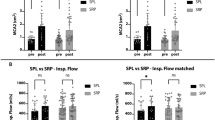Abstract
The aim of functional septorhinoplasty is to create an esthetically elegant nose and harmony in the face by preserving nasal function as well as maintaining or restoring adequate airway. Since nasal complaints are usually subjective, it may be difficult to evaluate the functions objectively. In the present study, we aimed to investigate the alterations in nasal function associated with septorhinoplasty by using both objective and subjective methods. The study population consisted of 40 patients who underwent septorhinoplasty and 40 healthy controls. Before and after the operation, visual analog scale, acoustic rhinometry, rhinomanometry, and Odiosoft-Rhino test were applied to all patients and controls. There were significant differences in all parameters both before and after the operation. While a significant difference was obtained between the patient and control groups in terms of preoperative values, no significant difference was found between postoperative values of these groups. Both objective and subjective methods are important in evaluations.



Similar content being viewed by others
References
Clark MP, Greenfield B, Hunt N, Hall-Craggs M, McGrouther DA (1998) Function of the nasal muscles in normal subjects assessed by dynamic MRI and EMG: its relevance to rhinoplasty surgery. Plast Recont Surg 101:1945–1955
Johnson PJ, Hollins R (2009) Internal nasal valve collapse. Arch Facial Plast Surg 11:64
Kantas I, Balatsouras DG, Vafiadis M, Apostolidou MT, Korres S, Danielidis V (2008) Management of inner nasal valve insufficiency. J Otolaryngol Head Neck Surg 37:212–218
Bull TR (1983) Rhinoplasty: aesthetics, ethics and airway. J Laryngol Otol 97:901–916
Tahamiler R, Alimoglu Y, Canakcioglu S (2011) Comparison of Odiosoft-Rhino and rhinomanometry in evaluation of nasal patency. Rhinology 49:41–45
Tahamiler R, Yener M, Canakcioglu S (2009) Detection of the nasal cycle in daily activity by remote evaluation of nasal sound. Arch Otolaryngol Head Neck Surg 135:137–142
Tahamiler R, Canakcioglu S (2008) Evaluation of nasal obstruction with Odiosoft-Rhino in nasal septal deviation. J Otolaryngol Head Neck Surg 37:285–291
Keefe MA, Cupp CL (1999) The septum in rhinoplasty. Otolaryngol Clin North Am 32:15–36
Berry RB (1981) Nasal resistance before and after rhinoplasty. Br J Plast Surg 34(1):105–111
Cummings CW, Fredrickson JM, Harker LA, Krause CJ, Richardson MA, Schuller DE (1998) Otolaryngology head and neck Surgery, 3rd edn. Mosby-Year Book, Inc, St. Louis
Grymer LF (1995) Reduction rhinoplasty and nasal patency: change in the cross-sectional area of the nose evaluated by acoustic rhinometry. Laryngoscope 105:429–431
Cole P, Chaban R, Naito K, Oprysk D (1988) The obstructive nasal septum. Effect of simulated deviations on nasal airflow resistance. Arch Otolaryngol Head Neck Surg 114:410–412
Teller DC (1997) Anatomy of a rhinoplasty: emphasis on the middle third of the nose. Facial Plast Surg 13:241–252
Wittkopf M, Wittkopf J, Ries WR (2008) The diagnosis and treatment of nasal valve collapse. Curr Opin Otolaryngol Head Neck Surg 16:10–13
Tatlıpınar AU, Keser R, Anadolu Y (2001) Acoustic rhinometric evaluation of septal deviations in pre and postoperative period. K.B.B. ve BBC Dergisi pp 68–73
Gilain L, Coste A, Ricolfi F, Dahan E, Marliac D, Peynegre R, Harf A, Louis B (1997) Nasal cavity geometry measured by acoustic rhinometry and computed tomography. Arch Otolaryngol Head Neck Surg 123:401–405
Cakmak O, Coşkun M, Celik H, Büyüklü F, Ozlüoğlu LN (2003) Value of acoustic rhinometry for measuring nasal valve area. Laryngoscope 113:295–302
Hilberg O, Jackson AC, Swift DL, Pedersen OF (1989) Acoustic rhinometry: evaluation of nasal cavity geometry by acoustic reflection. J Appl Physiol 66:295–300
Pallanch JF, McCaffrey TM, Kern EB (1988) Evaluation of nasal breathing function with objective airway testing. In: Cummings CW (ed) Otolaryngology head & neck surgery. 3rd edn., Mosby—Year Book Inc., Missouri pp 799–832
Yarıktaş M, Karaoğlan İ, Doğru H, Tüz M, Yasan H, Döner F (2004) Septorinoplasti sonrası burun hava akımının değerlendirilmesi. KBB Klinikleri 6:14–17
Schumacher MJ (2004) Nasal dyspnea: the place of rhinomanometry in its objective assessment. Am J Rhinol 18:41–46
Gordon AS, McCaffrey TV, Kern EB, Pallanch JF (1989) Rhinomanometry for preoperative and postoperative assessment of nasal obstruction. Otolaryngol Head Neck Surg 101:20–26
Chandra RK, Patadia MO, Raviv J (2009) Diagnosis of nasal airway obstruction. Otolaryngol Clin North Am 42:207–225
Seren E (2005) Frequency spectra of normal expiratory nasal sound. Am J Rhinol 19:257–261
Author information
Authors and Affiliations
Corresponding author
Rights and permissions
About this article
Cite this article
Erdogan, M., Cingi, C., Seren, E. et al. Evaluation of nasal airway alterations associated with septorhinoplasty by both objective and subjective methods. Eur Arch Otorhinolaryngol 270, 99–106 (2013). https://doi.org/10.1007/s00405-012-1974-y
Received:
Accepted:
Published:
Issue Date:
DOI: https://doi.org/10.1007/s00405-012-1974-y




